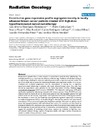Identificador persistente para citar o vincular este elemento:
https://accedacris.ulpgc.es/jspui/handle/10553/9025
| Título: | Constitutive gene expression profile segregates toxicity in locally advanced breast cancer patients treated with high-dose hyperfractionated radical radiotherapy | Autores/as: | Henríquez Hernández, Luis Alberto Lara Jiménez, Pedro Carlos Pinar, Beatriz Bordón, Elisa Rodríguez-Gallego, Carlos Bilbao, Cristina Fernandez-Perez, Leandro Flores Morales, Amílcar |
Clasificación UNESCO: | 320101 Oncología | Palabras clave: | Onto-Tools Ionizing-Radiation Dna-Damage Stage-Iii Design, et al. |
Fecha de publicación: | 2009 | Publicación seriada: | Radiation Oncology | Resumen: | Breast cancer patients show a wide variation in normal tissue reactions after radiotherapy. The individual sensitivity to x-rays limits the efficiency of the therapy. Prediction of individual sensitivity to radiotherapy could help to select the radiation protocol and to improve treatment results. The aim of this study was to assess the relationship between gene expression profiles of ex vivo un-irradiated and irradiated lymphocytes and the development of toxicity due to high-dose hyperfractionated radiotherapy in patients with locally advanced breast cancer. Raw data from microarray experiments were uploaded to the Gene Expression Omnibus Database http://www.ncbi.nlm.nih.gov/geo/ (GEO accession GSE15341). We obtained a small group of 81 genes significantly regulated by radiotherapy, lumped in 50 relevant pathways. Using ANOVA and t-test statistical tools we found 20 and 26 constitutive genes (0 Gy) that segregate patients with and without acute and late toxicity, respectively. Non-supervised hierarchical clustering was used for the visualization of results. Six and 9 pathways were significantly regulated respectively. Concerning to irradiated lymphocytes (2 Gy), we founded 29 genes that separate patients with acute toxicity and without it. Those genes were gathered in 4 significant pathways. We could not identify a set of genes that segregates patients with and without late toxicity. In conclusion, we have found an association between the constitutive gene expression profile of peripheral blood lymphocytes and the development of acute and late toxicity in consecutive, unselected patients. These observations suggest the possibility of predicting normal tissue response to irradiation in high-dose non-conventional radiation therapy regimens. Prospective studies with higher number of patients are needed to validate these preliminary results. | URI: | https://accedacris.ulpgc.es/handle/10553/9025 | ISSN: | 1748-717X | Otros identificadores: | http://dx.doi.org/10.1186/1748-717X-4-17 | DOI: | 10.1186/1748-717X-4-17 | Fuente: | Radiation Oncology[ISSN 1748-717X],v. 4 |
| Colección: | Artículos |
Vista completa
Citas SCOPUSTM
28
actualizado el 08-jun-2025
Citas de WEB OF SCIENCETM
Citations
21
actualizado el 08-jun-2025
Visitas
96
actualizado el 04-may-2024
Descargas
135
actualizado el 04-may-2024
Google ScholarTM
Verifica
Altmetric
Comparte
Exporta metadatos
Los elementos en ULPGC accedaCRIS están protegidos por derechos de autor con todos los derechos reservados, a menos que se indique lo contrario.
